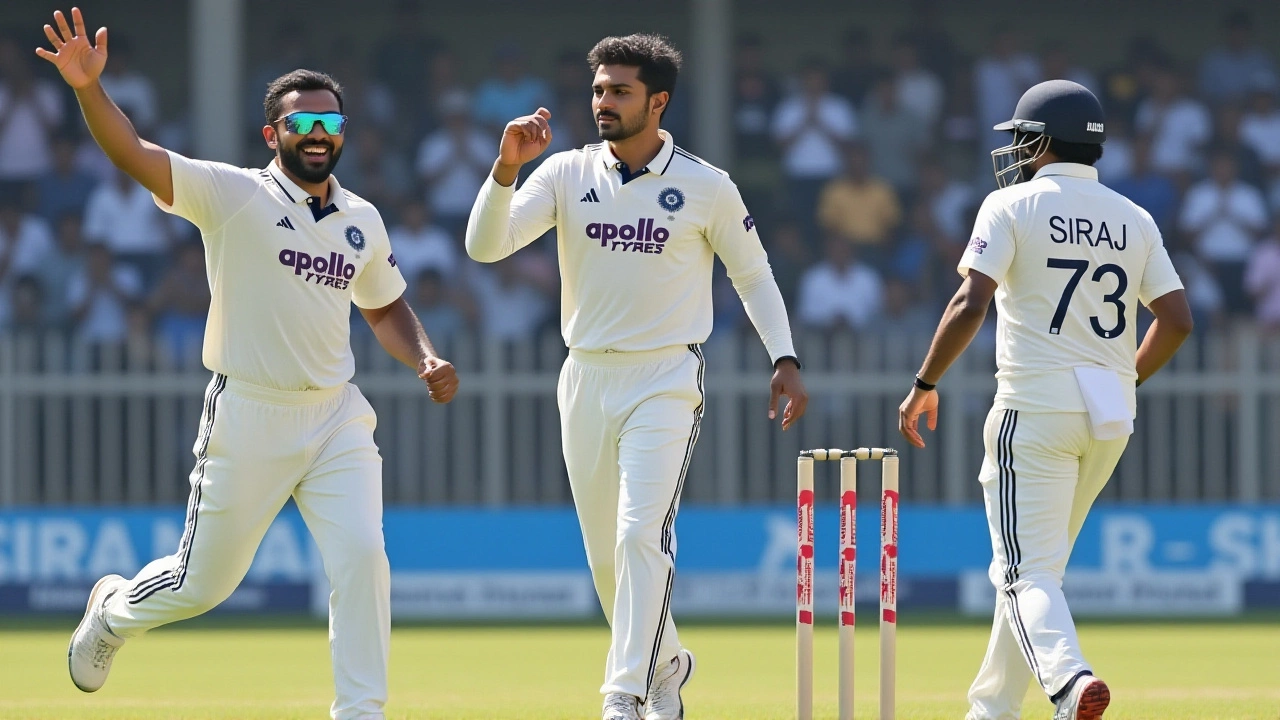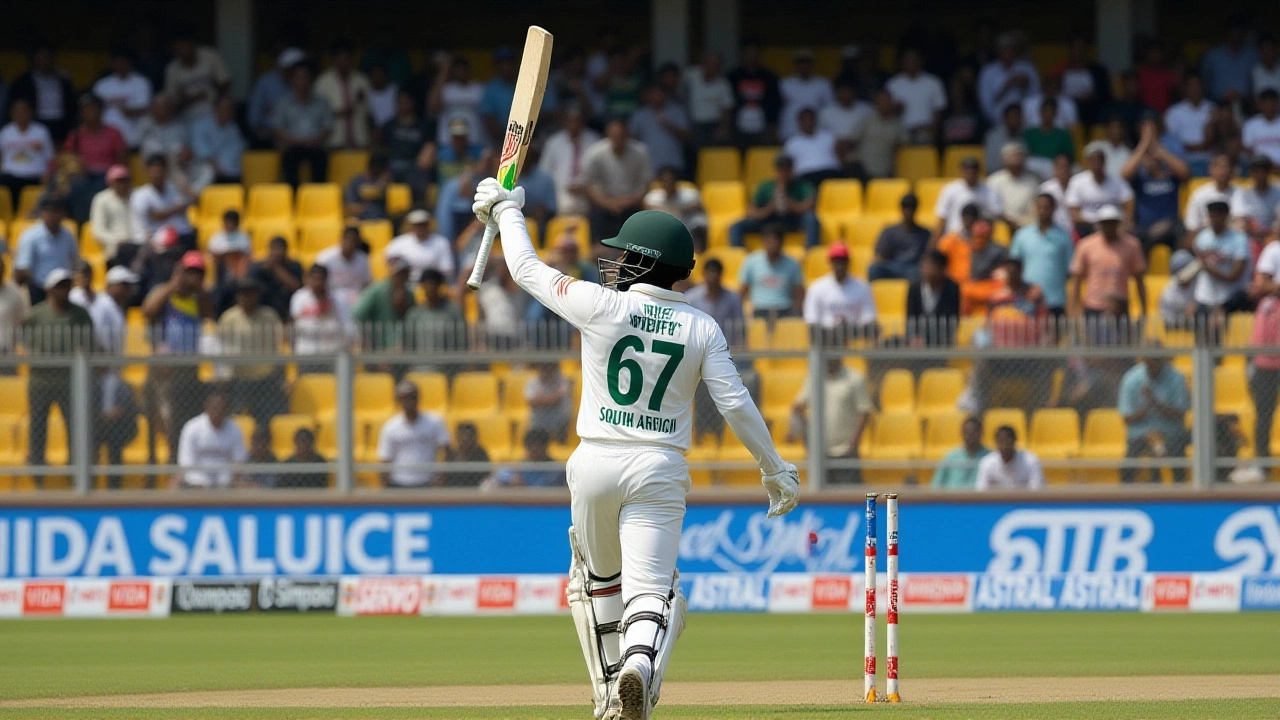On a sun-dappled afternoon in northeastern India, Senuran Muthusamy and Marco Jansen didn’t just bat — they rewrote the script. At Barsapara Cricket Stadium in Guwahati, South Africa reached 428/7 at lunch on day two of the second Test against India, thanks to a blistering, unbroken 94-run stand between the two all-rounders. Muthusamy, 32, smashed his maiden Test century — 107 not out off 203 balls — while Jansen, 25, played with such ferocity that even India’s famed spinners looked rattled. This wasn’t just a partnership. It was a statement.
Lower Order, Higher Stakes
No one expected South Africa’s lower order to dominate like this. After losing four wickets for 100 runs in the first session, the Proteas were teetering at 188/6. Enter Kyle Verreynne, who held firm for 45 off 122 balls before falling to Ravindra Jadeja, stumped while charging down the track. But then came Muthusamy and Jansen — two men who’d never batted together in a Test before, now stitching together one of the most crucial partnerships in recent South African touring history. Muthusamy, who entered at No. 7, became just the second visiting batter in the last 15 years — after Quinton de Kock — to score a Test century in India from that position. He started patiently, taking 121 balls to reach 50, then exploded. His century came off 192 deliveries, sealed with a punch wide of cover off Mohammed Siraj. "He’s not just batting; he’s thinking five moves ahead," said one former South African captain on commentary.Jansen’s Assault on the Spinners
If Muthusamy was the architect, Jansen was the demolition expert. His 51 not out off just 57 balls included four sixes — all of them launched over the infield against India’s spinners. Three came off Kuldeep Yadav (3/110), one off Jadeja (2/78). One particular heave over long-on, off Kuldeep’s left-arm wrist spin, sent the crowd into stunned silence before erupting in applause. "He’s not trying to score; he’s trying to intimidate," noted ENCA’s sideline reporter. Jansen’s aggression didn’t just score runs — it broke India’s rhythm. The spinners, usually India’s secret weapon on home soil, were reduced to defensive bowling. Jadeja, normally so composed, was seen shaking his head after Jansen cleared the ropes for the fourth time. Bumrah, India’s spearhead, went wicketless and conceded 63 runs in 13 overs. Siraj, the new-ball threat, was left with nothing but frustration.
Daylight, Deadlines, and Delhi’s Absence
The match is being played under unusual conditions. Due to early sunsets in Assam, play started at 9:00 a.m. local time — 30 minutes earlier than standard. The tea break comes after the first session, and the long lunch break follows. "It’s like playing chess in twilight," said South African coach Rob Walter. "You have to be sharp, and you have to finish what you start." Meanwhile, India is missing more than just daylight. Captain Shubman Gill, sidelined by injury, is absent from the field, with wicketkeeper Rishabh Pant leading the side. It’s the second Test in a two-match series, and South Africa, having won the first, now stands on the brink of their first series victory in India in 25 years.The Bigger Picture: A Historic Chance
South Africa’s 428/7 isn’t just a big score — it’s a psychological weapon. No team has lost a Test in India after scoring 489 or more. That’s the new target. With Muthusamy still at the crease and Jansen in full flow, South Africa could push past 500. And if they do, India’s batting lineup — already under pressure without Gill — may buckle under the weight of expectation. The lower-order surge isn’t random. It’s the result of years of tactical retooling by Cricket South Africa. Muthusamy, once seen as a fringe player, now averages 50.3 in Tests. Jansen, who once struggled to find his role, has become a genuine all-rounder. Their synergy? Pure instinct. "They don’t talk much. They just know," said former India spinner Harbhajan Singh on air.
What’s Next?
After lunch, South Africa will look to push beyond 500. If they do, India’s top order — already shaky against spin — will face a mountain. The Indian spinners, once dominant, now need answers. And for South Africa? This could be the innings that ends a quarter-century of frustration on Indian soil.Frequently Asked Questions
How rare is a Test century from No. 7 in India for a visiting batter?
Only two visiting batters have achieved this in the last 15 years: Senuran Muthusamy and Quinton de Kock. Before de Kock in 2021, the last was England’s Alastair Cook in 2012. It’s a feat that demands both patience and nerve on spinning tracks, where middle-order collapses are common. Muthusamy’s century is the 17th by a No. 7 batter in Test history against India — and only the third by a South African.
Why is the session order reversed at Barsapara Stadium?
Guwahati’s latitude means winter days are short, with sunset around 5:15 p.m. To maximize daylight, the BCCI adjusted session timing: play starts at 9 a.m., followed by a 20-minute tea break, then a 40-minute lunch break — the reverse of the traditional structure. This ensures the final session ends before darkness, avoiding lost playing time and keeping the match on schedule.
What impact does Shubman Gill’s absence have on India’s chances?
Gill’s injury leaves a leadership and batting void. He’s India’s most consistent opener this year, averaging 54 in home Tests. His absence has forced Rishabh Pant into a dual role — captain and finisher — which stretches his focus. Without Gill’s stability, India’s top order has averaged just 28.5 in the series, compared to 41.2 in their previous home Tests.
Has South Africa ever won a Test series in India?
Yes — but it’s been 25 years. South Africa’s last series win in India came in 1999–2000, when they triumphed 2–1 under Hansie Cronje. Since then, they’ve played 12 series in India and lost all of them, with their best result being a 1–1 draw in 2010. A win in this series would be historic — and would cement this generation as one of the most resilient South African touring sides ever.
How did Marco Jansen’s batting compare to previous all-rounder performances in India?
Jansen’s 51 off 57 balls is the fastest fifty by a South African No. 8 in India, beating the previous record held by Chris Morris (61 off 71 in 2018). His strike rate of 89.47 is the highest for any South African batter with a minimum of 50 runs in India since 2000. More impressively, his four sixes off spinners are the most by any batter in a single innings against India since 2019 — and the most by any overseas player in Guwahati.
What’s the significance of South Africa scoring over 400 in India?
Since 2010, only three visiting teams have posted 400+ in a Test innings in India — England (twice), Australia, and now South Africa. Of those, only England won the match. Scoring 428/7 puts South Africa in elite company and forces India to bat against a pitch that’s now 48 hours old — meaning more turn, less pace, and more pressure on the batsmen. Historically, teams scoring 400+ in India win 73% of the time.
